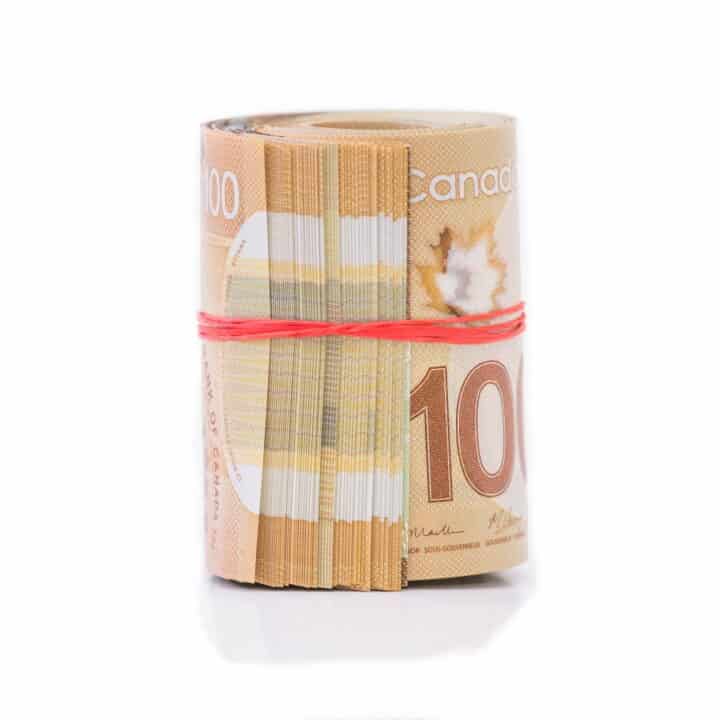Tax-Free Savings Account (TFSA) and the Registered Retirement Savings Plan (RRSP) are two of the most popular tools for Canadians looking to build a nest egg and save on taxes.
But what is the difference between an RRSP and a TFSA? Which one should you use and when?
In this article, we will be answering all your questions about RRSPs and TFSAs.
According to BMO’s 10th Annual RRSP study, 69% of Canadians currently hold an RRSP account. This equates to a huge 25.94 million people. However, TFSAs are quickly gaining in popularity, increasing more than 23% in the last five years. In fact, in 2020, 68% of Canadians said they had a TFSA, equating to 25.55 million people.
If you are trying to come up with savings strategies, you are probably debating which account is right for you – a TFSA or an RRSP. We thoroughly reviewed DCCP vs. RRSP, and also suggest you take a look at CPP changes here.
Although both accomplish similar goals, there are some differences between how TFSAs and RRSPs work. Generally, if you make over $50,000 CAD/year, then you’ll want an RRSP account. If you don’t, you’ll want to consider a TFSA – see best TFSA investments here. However, the devil is in the details.
Throughout this article, we will dive into the specifics of each account. We will look at various factors so that you can decide what is better for you, an RRSP or TFSA account.

How Do You Choose Between An RRSP Or TFSA?
RRSP
A Registered Retirement Savings Plan, popularly known as an RRSP is a registered account used in which you can hold savings and investments.
It is a tax-advantaged account created to encourage retirement savings. The money put in the best RRSP of your choice is exempt from taxation the year you make the deposit. In other words, you contribute pre-tax dollars to an RRSP (see ‘How Much RRSP Should I Contribute to Avoid Paying Taxes?).
However, there is a set limit to the amount of money you can put into your RRSP each year. This is your RRSP contribution limit (see also RRSP contribution deadline post).
Since the amount you put in your RRSP is directly deducted from your income, it has the effect of lowering your tax bill for that year. However, you are taxed when you start withdrawing from your RRSP post-retirement (see ‘RRSP Withdrawal Rules‘ and Withholding Tax post).
The logic behind this is that for most people, their income after retirement is less than their income in their prime earning years. Thus by investing in an RRSP, you defer paying taxes on your contribution amount till you retire. And most likely, you will be in a lower tax bracket when you retire.
Additionally, the capital contributed to your RRSP gets a chance to grow tax-free until it is withdrawn.
When you turn 71, you must convert your RRSP into an RRIF (Registered Retirement Income Fund). Alternatively, you can withdraw all the money that you have contributed to the RRSP up to that point (learn how to save as much as possible when withdrawing in this post here).
If you withdraw the money, it is taxable as if it were ordinary income. But that taxation becomes deferred if you transition the account into an RRIF.
Contributions to an RRSP are deductible for income tax purposes.

RRSPs at a glance
- You do not pay tax on money held in an RRSP, unless you withdraw from it.
- Contributions to your RRSP are deductions from your income, which results in lower taxable income.
- Both you and your spouse can contribute to your RRSP, which provides financial flexibility for you both after you retire.
- You can invest in U.S. stocks through your RRSP without paying non-resident withholding taxes.
- Money withdrawn from an RRSP account is taxable.
- RRSP accounts expire when you reach the age of 71.
- You can only contribute up to 18% of your earned income towards your RRSP in any given year. Alternatively, the contribution limit for 2021 is set at $27,830. Your contribution limit is based on which of these figures is lower.
TFSA
The Federal Government introduced TFSAs in 2009 to motivate Canadians to save more money. A TFSA is simply a tax-free savings account. Any money you invest in your TFSA grows completely tax-free. There are TFSA withdrawal rules you need to be aware of, however.
We like that if you make any money off your investments or savings in the account, they are not taxable. All your earnings stay with you even after you withdraw them.
We might call TFSAs “savings accounts”, but they operate more like an investment basket. They can contain investments like mutual funds, stocks, bonds, as well as cash.
With some financial institutions, the cash in your best TFSA of your choice also collects interest like a regular savings account. And the interest is exempt from taxation!

Sounds great, right? However, there are a few limitations.
For example, there are limitations to how much your annual TFSA contribution can contain. This is the contribution limit. This limit is announced by the CRA every year. It is benchmarked to inflation and rounded to the nearest 500.
The good news is that if you have not made the contribution in one year, it gets added to subsequent years. The table below shows TFSA limits for all the years since it was started.
In other words, if you have never invested in TFSA, you can invest a cool $75,500 in 2021.
| Year | TFSA Limit | Cumulative TFSA Limit |
| 2009 | $5,000 | $5,000 |
| 2010 | $5,000 | $10,000 |
| 2011 | $5,000 | $15,000 |
| 2012 | $5,000 | $20,000 |
| 2013 | $5,500 | $25,500 |
| 2014 | $5,500 | $31,000 |
| 2015 | $10,000 | $41,000 |
| 2016 | $5,500 | $46,500 |
| 2017 | $5,500 | $52,000 |
| 2018 | $5,500 | $57,500 |
| 2019 | $6,000 | $63,500 |
| 2020 | $6,000 | $69,500 |
| 2021 | $6,000 | $75,500 |
TFSAs at a glance
- You do not pay any tax on money earned in a TFSA.
- There are no consequences for withdrawing out of a TFSA, making it ideal for investors who have a medium-term goal in mind like purchasing a house or a car.
- TFSAs do not expire. Your investments can grow for as long as you want them to.
- If you do not max out your contribution limit one year, it carries over to the next. As of 2021 that cumulative contribution limit is $75,500.
- In the United States, the IRS does not recognize the TFSA as a retirement account making it an unideal tool to invest in U.S. stocks.
- There are limitations to how much you can contribute to your TFSA each year.
What is Common Between RRSP and TFSA?
Both RRSP and TFSA accounts offer you a way to save your money. Both of them are tax-advantaged accounts. They also afford you the ability to invest your money into mutual funds, stocks, bonds, and other investment types.
When it comes to deciding which type of account is better when planning out your savings goals, there are a variety of factors to consider.
Both Offer Advantages Depending On Your Tax Bracket

In the ideal world, you should use both an RRSP and a TFSA to attain your financial goals. The question is, which instrument should you use first?
If your income is over $50,000 annually, then you can use an RRSP to reduce your tax bill. Anything left over after you have paid your bills and made your RRSP contribution should go into your TFSA.
However, if your income is less than $50,000 annually then you might want to first contribute to a TFSA.
If you have less income, then you are probably going to want fewer barriers to accessing your money when you need to.
In this respect, the TFSA is superior to an RRSP because there are no drawbacks to withdrawals. Also, there are no tax consequences when you withdraw from a TFSA.
Both Allow You to Invest Your Money

What type of investment are you interested in? There is a wide variety of investments to choose from, including stocks, bonds, and mutual funds. Both the RRSP and TFSA grant you the ability to invest in various financial vehicles. At the same time, in their own ways, they shelter your savings from taxes.
Both Place a Limit On Contributions
How much can you contribute to the two accounts?
Both types of accounts are similar in that there is a limitation to how much you contribute. With an RRSP account, you are only able to contribute 18% of your income for a given year. So, if you make $50,000, it amounts to $9,000.
RRSPs also have an alternative contribution limit. For the year 2021, the limit was $27,830. Any unused RRSP contribution room gets cumulatively carried forward.
With a TFSA account, there is a contribution limit that varies from year to year. From 2019-2021 the contribution limit for TFSA accounts has remained steady at $6,000. Any unused limit for TFSA gets carried forward to subsequent years.
Therefore, if you have been eligible for a TFSA since 2009 but have never contributed, your cumulative contribution limit is currently $75,500.
So, the account that makes the most sense for you is going to depend on how much money you make per year, and where you expect yourself to fall on the marginal tax rate after you retire.
A TFSA makes more sense if you expect that your income is going to be higher when you retire than it is currently. You will be contributing money when your tax rate is lower and then withdrawing it when your tax rate is higher. In other words, you can legally escape paying higher taxes. However, an RRSP may be more advisable if you expect your retirement income to be lower than your current income.

What is the Difference Between an RRSP and a TFSA?
- Investing in US stocks: if you are contributing to an RRSP you can invest in U.S. stocks while avoiding paying non-resident withholding taxes. This reduces the barrier to investing in some of the most profitable companies in the world like Apple, Walmart, and Amazon. The IRS does not recognize a TFSA as a retirement account.
- No penalties for withdrawals: If you are keeping your money in a TFSA, you do not have to worry about paying taxes on money that you withdraw. If you feel that withdrawing money from your retirement account is something you will have to do then opt for a TFSA. You can make a withdrawal and it will not cost you any more money. An RRSP gets taxed.
- Tax-deductible: if you are contributing your money to your RRSP then that is deductible from your income. This results in lower taxable income which means more money in your pocket in the short term. Money contributed to your TFSA however is not deductible from your income.
- Spousal retirement savings tool: there are spousal RRSP accounts that a common-law couple can use to save for their retirement together.
Use An RRSP Account If:
- You make over $50,000 annually.
- You want contributions to your account to count as deductibles for your income.
- You want to invest in U.S. stocks without paying non-resident withholding taxes.
- You expect that your income will not be greater once you retire.

Use A TFSA Account If:
- You do not make over $50,000 annually.
- You expect that you are going to want to withdraw money in the medium-term for a large purchase, like a house or car.
- You want to invest your money and have the earnings be exempt from taxation.
- You are interested in an account that generates interest and is exempt from taxation.
- You expect that your income is going to be higher after you retire than it is currently.

The Bottom Line
The bottom line is that you should invest in both TFSAs and RRSPs. But if you are starting out or you can not invest in both of the accounts simultaneously, you are best off investing in TFSA first and RRSP subsequently.
Which savings account works best for you depends on your present income and where you expect your finances to be at the time of retirement. Retirement planning can be difficult. But we hope that over the course of this article we have helped you gain clarity on whether an RRSP or TFSA makes more sense for you.